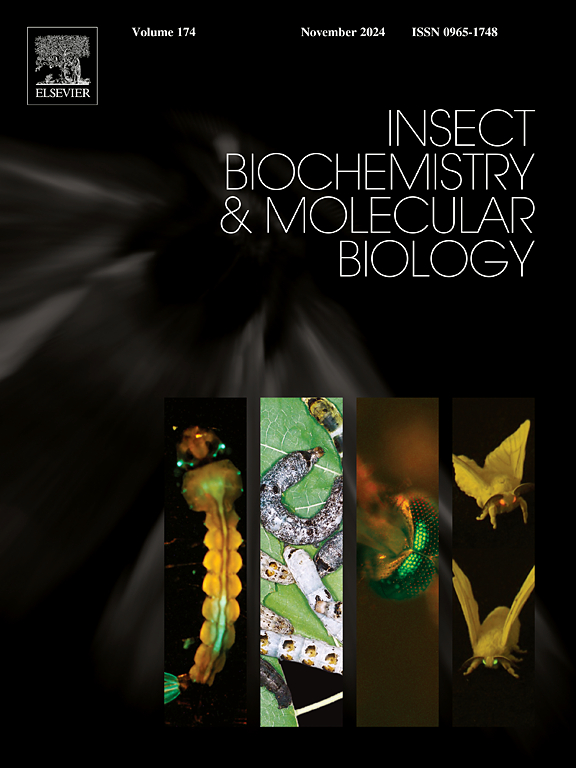灰鼠科dopa -脱羧酶基因的谱系特异性重复和功能多样化研究
IF 3.2
2区 农林科学
Q2 BIOCHEMISTRY & MOLECULAR BIOLOGY
引用次数: 0
摘要
多巴脱羧酶(DOPA-decarboxylase, DDC)基因对多巴胺合成至关重要,并影响昆虫的多种生物功能,包括身体颜色、行为、学习和睡眠。然而,它对进化的影响在很大程度上仍未被探索。本研究报道了灰蟋蟀科两个真正的ddc基因(ddc1和ddc2)的串联重复。本文以双斑斑鸠(Gryllus bimaculatus, Gb)为模型,研究了ddc1和ddc2的功能。我们的研究结果显示,Gb'ddc1是全身性表达的,与黑色素沉着后的阶段相比,它在蜕皮后的表达更高。在通过CRISPR/Cas9产生的Gb'ddc1纯合子敲除突变体中,体色色素沉着减少,角质层半透明,多巴胺水平降低,多巴胺过度积累。这些突变体在孵化后不久就死亡了,可能是由于角质层缺陷,这强调了多巴胺在黑色素合成中的重要作用,多巴胺是由Gb'ddc1产生的。相反,Gb'ddc2的表达局限于卵巢,在蜕皮后不上调。Gb'ddc2纯合子敲除突变体无体色缺陷,但孵化率和胚胎发育率显著降低。有趣的是,在Gb'ddc2突变体中,卵巢中的多巴胺水平显著升高。这表明由Gb'ddc2调节的正常卵巢多巴胺水平对维持生育能力至关重要。Gb'ddc2的功能不同于典型的ddc,表明通过进化复制实现了新功能化。总的来说,Gb'ddc1和Gb'ddc2具有不同的功能,使用这两个ddc基因精确调节卵巢多巴胺水平可能提高了蟋蟀的生育能力。本文章由计算机程序翻译,如有差异,请以英文原文为准。

Lineage-specific duplication and functional diversification of DOPA-decarboxylase genes in the Gryllidae family, as revealed in Gryllus bimaculatus
The DOPA-decarboxylase (DDC) gene is crucial for dopamine synthesis and influences various biological functions in insects, including body coloration, behavior, learning, and sleep. However, its evolutionary impact remains largely unexplored. This study reports on the tandem duplication of two bona fide ddc genes (ddc1 and ddc2) in the Gryllidae cricket family. We herein investigated the function of ddc1 and ddc2 using Gryllus bimaculatus (Gb) as a model. Our results revealed that Gb'ddc1 was expressed systemically, with its expression being higher immediately after molting compared to the stage following melanin pigmentation. In homozygous knockout mutants of Gb'ddc1, generated via CRISPR/Cas9, reduced body color pigmentation and had translucent cuticles, decreased dopamine levels, and over-accumulated DOPA. These mutants died shortly after hatching, likely due to cuticle defects, underscoring the essential role of dopamine, produced by Gb'ddc1, in melanin synthesis. Conversely, Gb'ddc2 expression was confined to the ovary and was not up-regulated after molting. Homozygous knockout mutants of Gb'ddc2 exhibited no body color defects, whereas hatchability and embryonic development rates were significantly reduced. Interestingly, dopamine levels in the ovaries were significantly elevated in Gb'ddc2 mutants. This suggests that normal ovarian dopamine levels, modulated by Gb'ddc2, are vital for fertility maintenance. The function of Gb'ddc2 differs from that of typical ddc, indicating neofunctionalization through evolutionary duplication. Overall, Gb'ddc1 and Gb'ddc2 have distinct functions, and precise regulation of ovarian dopamine levels using these two ddc genes may have enhanced cricket fertility.
求助全文
通过发布文献求助,成功后即可免费获取论文全文。
去求助
来源期刊
CiteScore
7.40
自引率
5.30%
发文量
105
审稿时长
40 days
期刊介绍:
This international journal publishes original contributions and mini-reviews in the fields of insect biochemistry and insect molecular biology. Main areas of interest are neurochemistry, hormone and pheromone biochemistry, enzymes and metabolism, hormone action and gene regulation, gene characterization and structure, pharmacology, immunology and cell and tissue culture. Papers on the biochemistry and molecular biology of other groups of arthropods are published if of general interest to the readership. Technique papers will be considered for publication if they significantly advance the field of insect biochemistry and molecular biology in the opinion of the Editors and Editorial Board.

 求助内容:
求助内容: 应助结果提醒方式:
应助结果提醒方式:


